Have you ever wondered where Bali, the famous Indonesian island, is located in the world? Let’s uncover the mystery and explore Bali’s unique charm within the vast expanse of the ocean.
Bali is an island located in the Indonesian archipelago, south of the equator and surrounded by the Indian and Pacific Oceans. It is situated between the islands of Java and Lombok, and forms a part of the Lesser Sunda Islands.
Bali is known for its stunning beaches, lush greenery, and vibrant culture. It is a popular tourist destination that attracts millions of visitors from around the world each year. Its location in the middle of the world’s largest archipelago has made Bali a unique and important place in the world.
Key Takeaways
- Bali is an island located in the Indonesian archipelago.
- It is located south of the equator and surrounded by the Indian and Pacific Oceans.
- Bali is situated between the islands of Java and Lombok, and forms a part of the Lesser Sunda Islands.
- Bali is a popular tourist destination that attracts millions of visitors from around the world each year.
- Its location in the middle of the world’s largest archipelago has made Bali a unique and important place in the world.
Bali’s Geographic Location
Bali, a province of Indonesia, is located between the islands of Java and Lombok. The province’s capital is Denpasar, located in the southern part of the island. Bali occupies an area of 5,636 km², with a population of over 4 million people.
The island is situated in the westernmost end of the Lesser Sunda Islands, lying between the Bali and Lombok straits. It is located approximately 8 degrees south of the equator and about 2,000 km from the Australian continent.
Bali is part of the Coral Triangle, the global center of marine biodiversity. The island is surrounded by the Bali Sea to the north, the Indian Ocean to the south, and the Java Sea to the west.
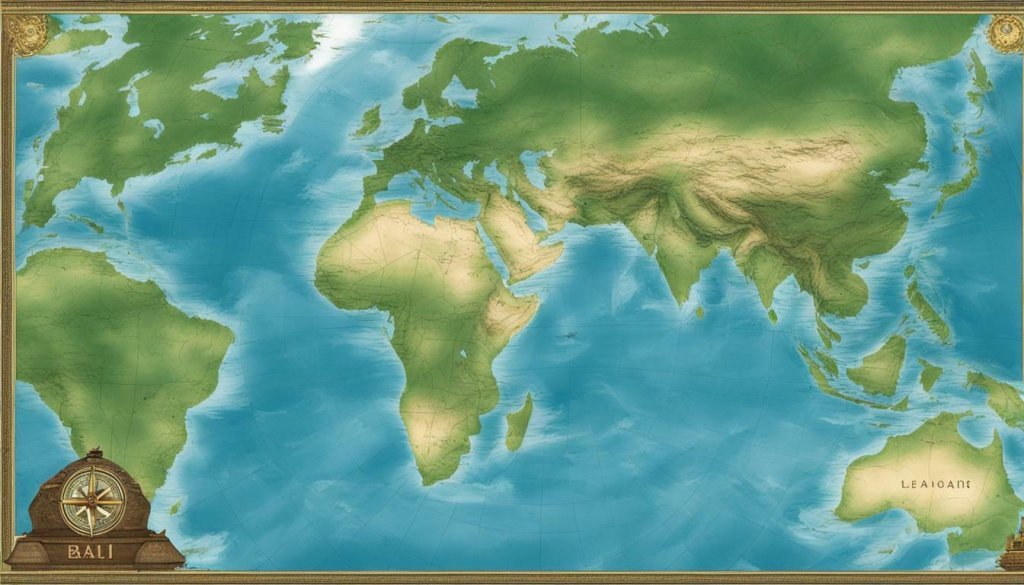
Bali’s global position is unique as it is part of the world’s largest archipelago and the world’s most populous island country. Bali’s location on the westernmost end of the Lesser Sunda Islands places it directly in the path of the Indonesian Throughflow, a critical current that flows between the Pacific and Indian Oceans, connecting the two largest oceans on Earth.
Bali’s Place on the World Map
Located at the westernmost end of the Lesser Sunda Islands, Bali is part of the country of Indonesia. Bali is situated between Java to the west and Lombok to the east and is one of the country’s 33 provinces. Its coordinates are 8.3405° S, 115.0920° E, placing it in the Southern Hemisphere and within the Pacific Ring of Fire.
On a world map, Bali can be found south of the equator and just east of Java, the most populous island in Indonesia. It is also surrounded by the Bali Sea and the Indian Ocean, which give the island its unique geographic and climatic features.
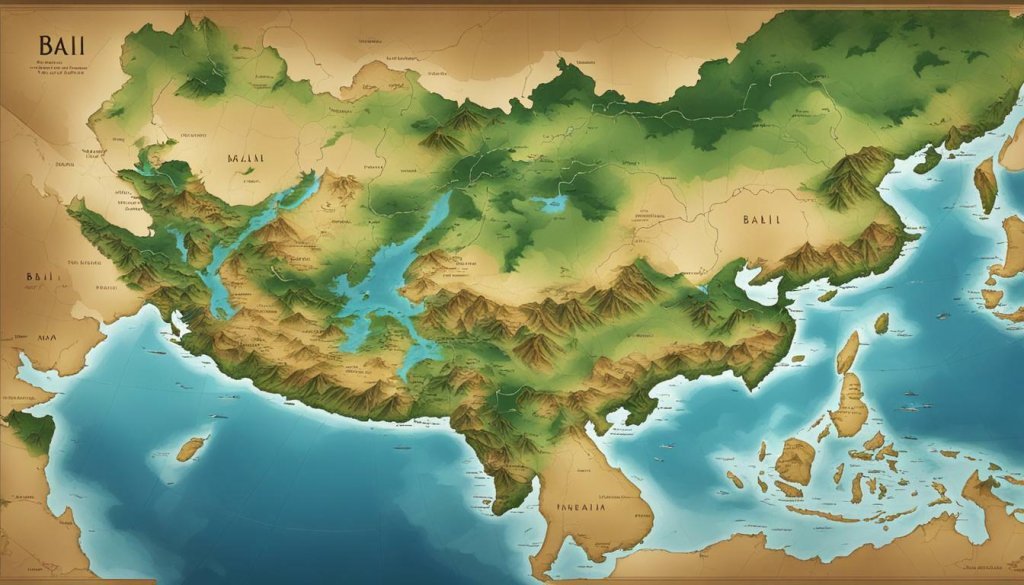
Bali’s location on the world map has made it an easily accessible tourist destination, with many people flocking to the island to enjoy its warm climate, beautiful beaches, and vibrant cultural scene. As such, Bali has become an important player in the global tourism industry, contributing significantly to Indonesia’s economy.
However, Bali’s position in the world also presents challenges, such as the need to balance economic development with preserving its natural and cultural heritage. Nevertheless, Bali remains a unique and enchanting destination that continues to captivate visitors from around the world.
Bali’s Surrounding Waters
Bali is located in the heart of the Indonesian archipelago and is surrounded by the Bali Sea to the north, the Indian Ocean to the south, and the Java Sea to the east. Bali’s location in the world has made it a significant center of trade and commerce, connecting the eastern and western hemispheres.
The Bali Sea is an important water body, extending eastward from the Java Sea and westward from the Lombok Strait. It is an integral part of the Coral Triangle and is renowned for its high levels of biodiversity. Bali also lies in close proximity to other islands such as Lombok, Java, and Sumatra, making it a hub of activity in the region.
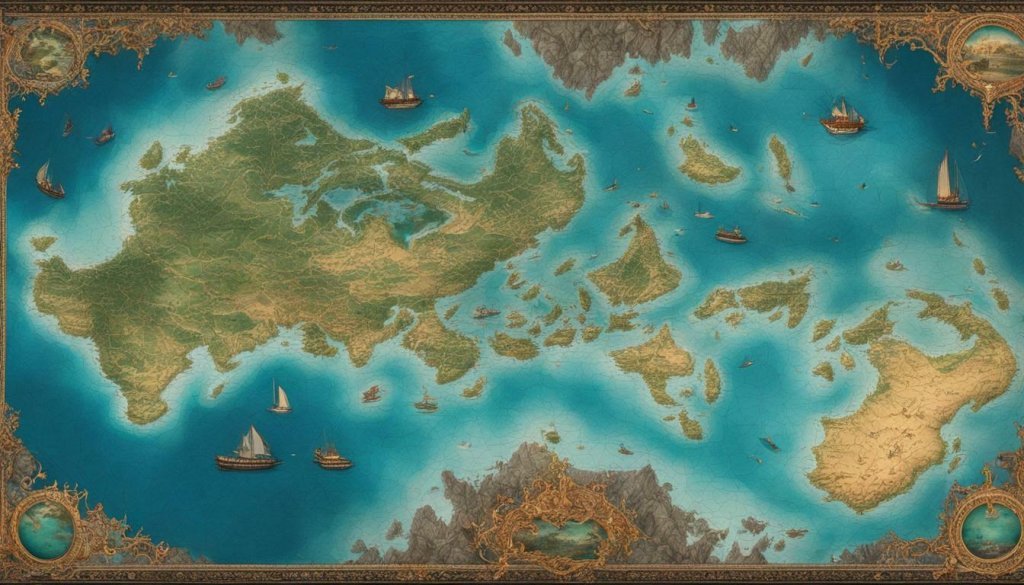
The Indian Ocean bordering Bali is vast and covers approximately 20% of the Earth’s surface. It is known for its warm waters and abundant marine life, making it a popular destination among surfers and divers.
With Bali’s strategic location in the world and its surrounding waters, it is no wonder that the island has played a significant role in global trade and commerce for centuries.
Bali’s Relation to Indonesia
Bali is a small island located in the westernmost end of the Lesser Sunda Islands, lying between the islands of Java to the west and Lombok to the east. It is part of Indonesia, a country in Southeast Asia that stretches over 1,904,569 square kilometers. Bali’s location within Indonesia is significant, as it is one of the most popular tourist destinations in the country.
Indonesia is the world’s largest archipelago, consisting of more than 17,000 islands, and Bali is one of its most well-known islands. Bali’s location within Indonesia places it in a strategic position on the world map. It is situated in the heart of Southeast Asia and is surrounded by the Indian and Pacific Oceans.
Bali’s geographic location and its relationship to Indonesia allow it to contribute significantly to the country’s tourism and economy. Bali’s global position as a cultural and tourist hotspot has made it a must-visit destination for travelers from all over the world.
Despite its popularity as a tourist destination, Bali faces challenges in preserving its unique identity and culture. The island’s rapid development and growth as a tourist hub threaten to erode the traditional way of life of the Balinese people. However, Bali’s government and tourism industry are actively working to ensure that the island remains a sustainable and culturally rich destination.
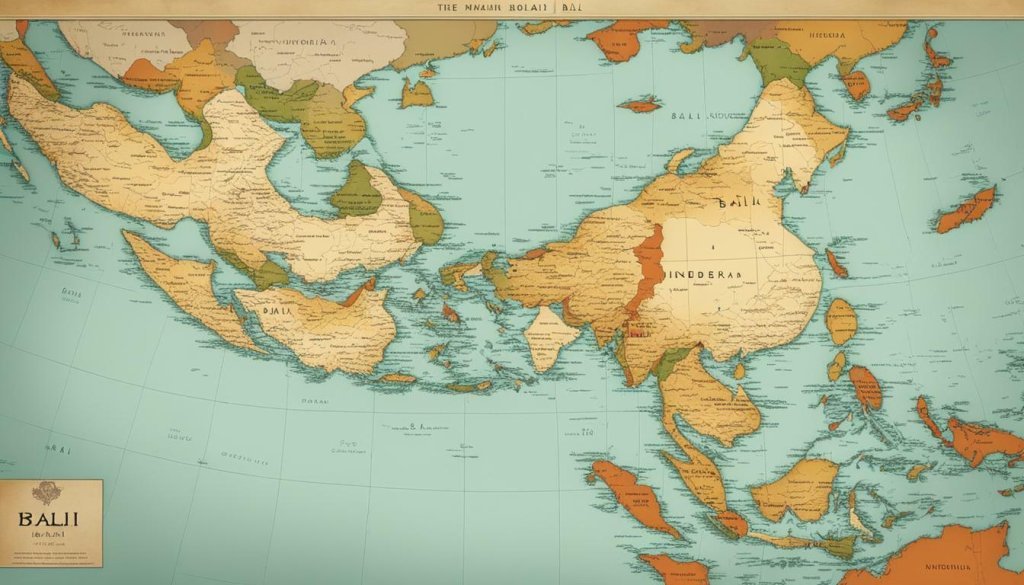
Overall, Bali’s location within Indonesia plays a significant role in its global position as a renowned tourist destination. Its unique cultural heritage and stunning landscapes continue to attract visitors from around the world, and its position within Indonesia highlights the country’s significance as a tourist and economic powerhouse in Southeast Asia.
Bali’s Unique Island Charm
Bali’s strategic location not only makes it a hotspot for tourists, but also adds to its unique island charm. The island is situated in the westernmost end of the Lesser Sunda Islands, lying between Java to the west and Lombok to the east.
Despite its relatively small size, Bali is home to a wide range of landscapes and ecosystems, from lush tropical forests and towering volcanoes to sandy beaches and coral reefs. This diversity is due to Bali’s location in the Coral Triangle, one of the world’s most ecologically diverse regions.
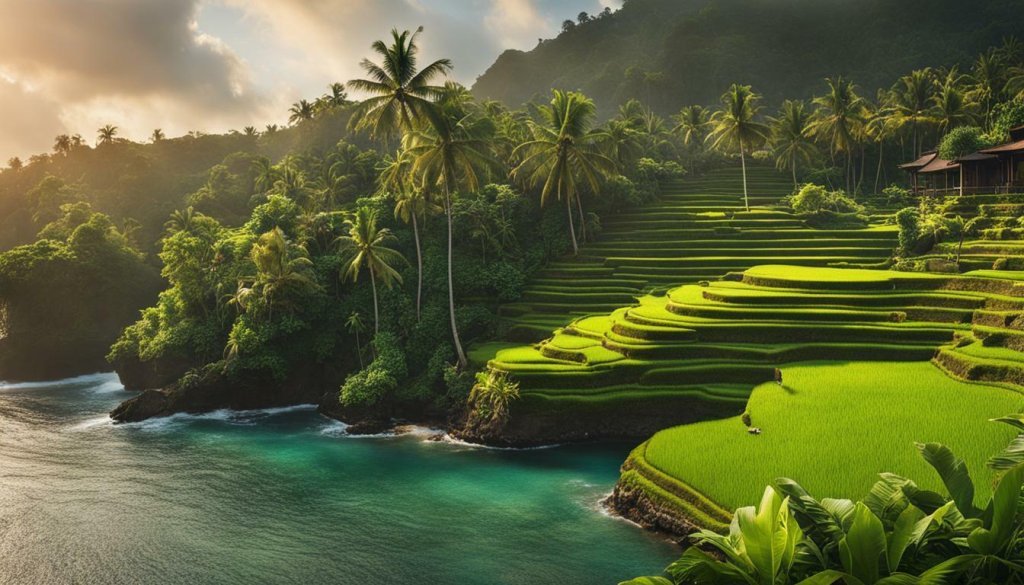
Bali’s geographic location has also contributed to its rich cultural heritage. Over the centuries, the island has been influenced by trading partners from India, China, and the Middle East, leading to a unique blend of Hinduism, Buddhism, and Islam. Bali is also known for its traditional arts and crafts, such as intricate wood carvings and colorful textiles, which are deeply rooted in the island’s cultural identity.
Today, Bali’s allure as a tourist destination continues to draw visitors from all over the world, with its stunning natural beauty, vibrant culture, and warm hospitality. Its position in the world has also made it a hub for international trade and commerce, further cementing its importance on the global stage.
Bali’s Climate and Geography
One of the most defining aspects of Bali is its unique climate and geography. Located in the heart of the Indonesian archipelago, Bali’s position close to the equator means that it experiences warm and humid weather year-round.
The island is home to a diverse landscape, ranging from sandy beaches to lush rainforests and terraced rice fields carved into the hillsides. Mount Agung, an active volcano, dominates the island’s eastern skyline and is considered a sacred site by many Balinese Hindus.
Bali’s geography also plays a significant role in shaping its weather patterns. The island’s central mountains create a rain shadow effect, resulting in a wetter climate on the northern side and a drier climate on the southern side.
Overall, Bali’s climate and geography contribute to its unique charm and draw visitors from all around the world to explore its natural beauty.
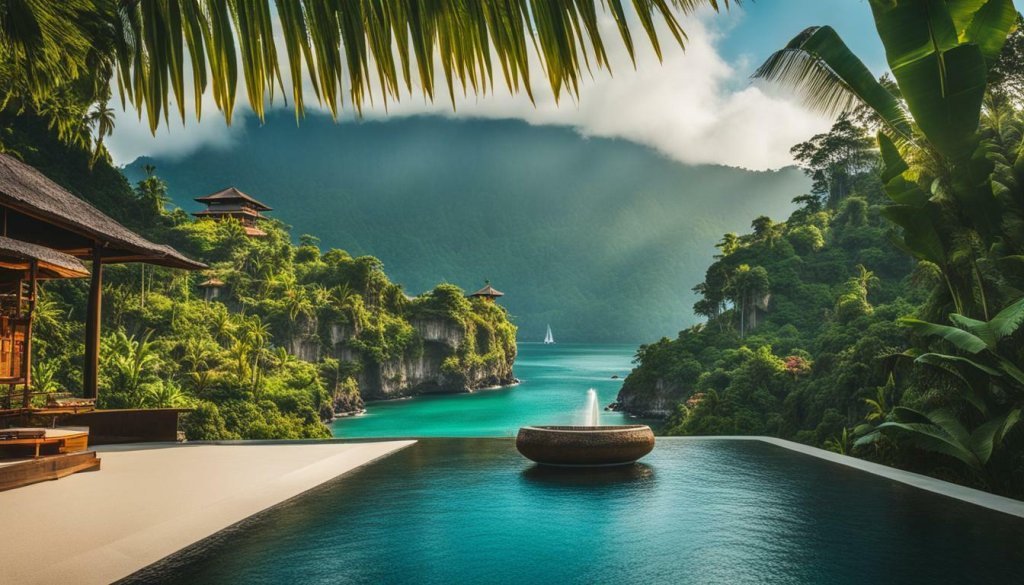
Bali’s Global Significance
Bali, a small island located in Indonesia, has gained global recognition for its beauty, unique culture, and popularity as a tourist destination. Its location in the world plays a crucial role in its global significance as it is an essential part of the Indonesian archipelago. Bali’s world location is strategically situated between the Java Sea and the Indian Ocean, making it accessible to the world’s major trading routes.
The Bali location has been a significant factor in its reputation as a hub for tourism and has contributed significantly to Indonesia’s cultural identity. Bali’s geographic location has made it a world-famous resort destination, attracting millions of visitors annually. Moreover, Bali’s unmatched beauty inspires artists, photographers, and nature enthusiasts from all over the world.
Bali’s global position has also made it a vital player in the international travel industry, fueling the growth of Indonesia’s economy. The progress in Bali’s economic development can be attributed to its position as a global tourist destination. Bali in the world is also a major contributor to the country’s export earnings, making up a significant portion of Indonesia’s commercial revenue.
Bali’s location in the world has also played a key role in driving international cooperation in addressing global challenges. The island’s rich cultural heritage has contributed to global cultural diversity, and its response to climate change illustrates its role in promoting sustainable development worldwide. Bali has hosted several international meetings and conferences that have led to global cooperation in addressing issues such as climate change, disaster management, and sustainable tourism.

Bali’s location in the world has made it a globally significant island that impacts various aspects of Indonesian society and international relations. Its beauty, culture, and strategic location will continue to make Bali a crucial player in the global community for years to come.
Bali’s Position in the World Today
Bali, with its enchanting location in the world, has emerged as a significant player in the global market. Its unique geography has allowed it to develop a thriving tourism industry that attracts millions of visitors annually.
As a part of the Indonesian archipelago, Bali’s location has been instrumental in shaping its current position. Bali’s strategic location in Southeast Asia has contributed to its role in global trade, and its proximity to other neighboring islands has stimulated economic growth.
Despite its success, Bali faces challenges in preserving its unique identity. Rapid development, increasing traffic, and a growing population pose a threat to the island’s delicate balance of nature and culture.
Nevertheless, Bali’s global significance cannot be overlooked. Its contributions to the international travel industry, cultural heritage, and environmental conservation make Bali a vital player in the world today.
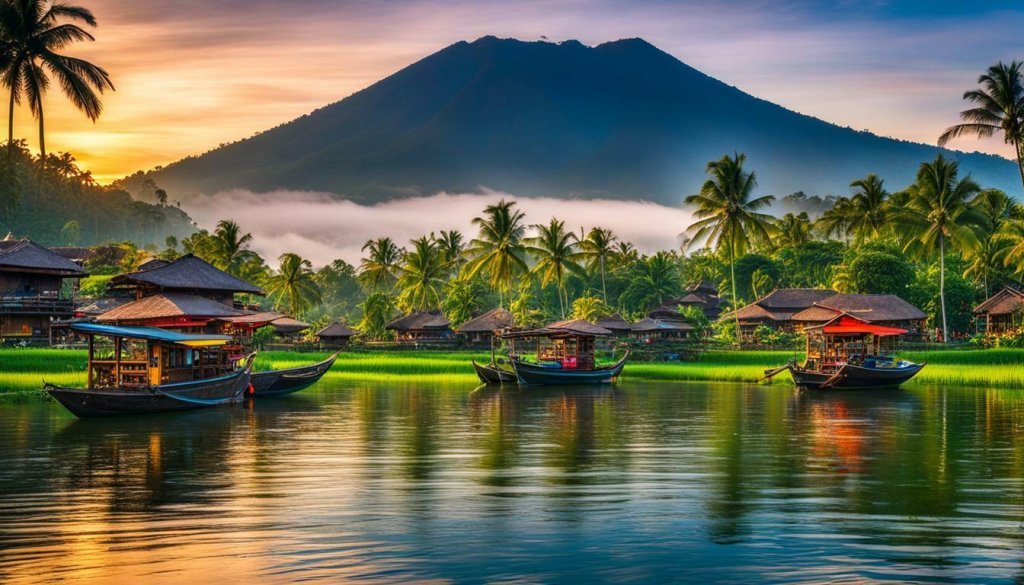
Bali’s position in the world today is a result of its location, climate, and geography. The island’s natural landscapes, cultural heritage, and welcoming atmosphere continue to attract visitors from around the globe. Bali’s future lies in its ability to balance economic growth with cultural preservation and environmental conservation.
Conclusion
In conclusion, Bali’s location in the world is a topic of intrigue and fascination. This tropical island paradise is situated in Indonesia, one of the largest archipelagos in the world. Bali’s unique charm and beauty can be attributed to its geographic location, which has influenced its climate, geography, and culture.
Bali’s position on the world map is significant, not just because of its stunning natural landscapes but also because of its global significance. As a top tourist destination, Bali has made a significant impact on the international travel industry. Bali’s economy is also showing signs of growth and development, and the island’s position in global trade continues to evolve.
Despite Bali’s progress, it still faces challenges in preserving its unique identity in the face of globalization. However, Bali remains a beacon of hope for countries the world over, proving that it is possible to embrace modernity while still holding onto a rich and vibrant cultural heritage.
So, where is Bali located in the world? It is located in the heart of Southeast Asia, surrounded by the Indian and Pacific Oceans. Its captivating location, combined with its unique cultural and natural attractions, makes Bali a destination that is worth exploring at least once in a lifetime.
FAQ
Where is Bali located in the world?
Bali is located in Indonesia, which is a country in Southeast Asia. Specifically, Bali is part of the Indonesian archipelago and is situated between the islands of Java and Lombok.
What is Bali’s geographic location?
Bali is positioned at approximately 8 degrees south of the equator and 115 degrees east of the Prime Meridian. It is known for its tropical climate and stunning natural landscapes.
How can I find Bali on a world map?
To locate Bali on a world map, you can look for Indonesia, which is located in Southeast Asia. Bali is one of the islands within Indonesia and can be found towards the eastern side of the archipelago.
What are the surrounding waters of Bali?
Bali is surrounded by the Bali Sea to the north, the Indian Ocean to the south, and the Bali Strait to the east, which separates Bali from the neighboring island of Lombok.
How does Bali relate to Indonesia?
Bali is part of the Republic of Indonesia and is one of its provinces. Indonesia is an archipelagic country made up of thousands of islands, with Bali being one of the most famous and popular destinations within the country.
What makes Bali unique as an island?
Bali is known for its unique island charm, which encompasses its breathtaking beaches, lush rice terraces, vibrant culture, and welcoming locals. It is a blend of stunning natural beauty and rich cultural heritage.
How does Bali’s location affect its climate and geography?
Bali’s location near the equator and surrounded by water influences its tropical climate, with warm temperatures year-round. Its geography consists of volcanic mountains, fertile valleys, and beautiful coastlines.
Why is Bali globally significant?
Bali holds global significance as a top tourist destination renowned for its stunning landscapes and vibrant cultural scene. It has made significant contributions to the international travel industry and has become a symbol of tropical paradise.
What is Bali’s current position in the world?
Today, Bali is an important player in the global tourism market, attracting millions of visitors each year. It has also faced challenges in maintaining its cultural identity while adapting to rapid economic development and globalization.


Comments